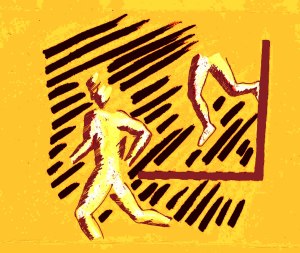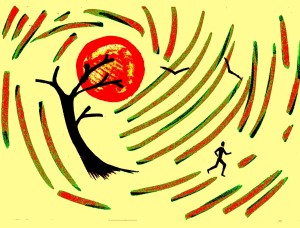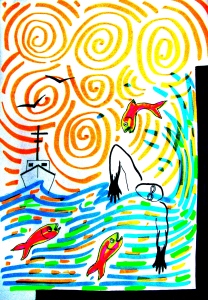It was weekend in Delhi.
The cafes of Khan Market were still prepping for the day.
The one we were in was quiet.
We were the day’s first customers or nearly so.
The man before me was athletic.
He had an easy smile that hid an underlying intensity, which surfaced when he spoke about his life lost to fate and circumstance till step by step it gained wings.
I pulled out my notebook; then took a sip from the cup of cappuccino.
The story commenced at Baoli in Baghpat, roughly 50km away from Delhi.
Arun was born the second of eight children – four brothers, four sisters. His father Jaswant Singh was a teacher at the government owned Central School. From class two onward, every year Arun succumbed to malaria. The annual bout of malaria would cease only when he reached his penultimate year of graduation in college. He grew up a weak child.
He was a small person, typically seated up front in class and not robust to play any games. “ My son who is now in the eighth standard weighs 40 kilos. In class nine, I weighed 26 kilos,’’ Arun said. In class nine, another defining spate of illness started. Arun got an infection of the parotid gland, a major salivary gland located between the mouth and the ear. Its cure was a daily injection repeated 90 days.
The course got over. But the infection continued. One side of the boy’s face was swollen, disfiguring his appearance. Around the time of class nine exams, he was taken to the larger hospital in Meerut. There, the doctors identified it as parotid tumour.
After the exams, he was hospitalized for surgery. The tumour was removed. Within four months the tumour returned. In the winter of class ten, a second operation was scheduled and the tumour removed for a second time. Ahead of class ten exams, the tumour returned again. After the exams, Arun had his third surgery to remove the tumour.
The family had thought of sending him for a diploma course in some trade. Arun cleared his tenth exams with decent scores and secured admission for studying commerce. His father, having moved to Delhi wished for the family to join him. But Arun’s tumour flared up for a fourth time. The boy was back to seeing doctors.
The prime cause of tension in the recurrent tumour was – all the surgeries so far and the ones to be done were close to facial nerves. A spate of extended hospitalization began. In Delhi, most of Arun’s eleventh standard days were spent hospitalized. “ I used to write to the hospital authorities seeking leave to attend important days in school,’’ he said outlining his predicament. Studies suffered. After his class eleven exams, the fourth operation to eliminate the tumour took place. This time, the incision was bigger, needing 14 stitches to close. “ The doctors said they burnt the whole area – that was the wording they used,’’ Arun said. In any case, the tumour hasn’t returned since.
By class twelve, the young man had a body weight of 37 kilos. He joined college to graduate in commerce; a three year-program in the second year of which, the last of those annual malaria bouts happened. With that, Arun’s history of being consistently sick died out.
It was in the second year of his degree course that Arun started exercising, the first dose of physical exercise for a body locked up since childhood in illness. Arun remembers those first few days of physical workout. He was so weak that he could do no more than two push-ups at a time. So he kept the sets small and slowly, determinedly cranked up the repetitions. In less than a year, he was doing impressive numbers.
Arun’s father taught geography at school. Income was limited. Tuitions can augment teacher’s salary. But who seeks tuitions for geography? It wasn’t a subject anyone sought tuitions in. To contain expense on food and to ensure supply of good quality milk, the family kept cows and buffalos. After they bought a plot of land in Ghaziabad, Arun’s family moved that side, staying there from 1989-2003. In 2003, they moved to Dwarka.
While in college, Arun got a taste of wrestling. During his Ghaziabad years, he was also associated with a training centre for wrestlers – an akhara. “ Wrestling wasn’t for me,’’ he said. However he appreciated the training. Meanwhile a dose of football resulted in a wrist injury that capped his ability to bench press. Nevertheless these were the turnaround years. “ Since 1988, I haven’t been sick in a significant way,’’ Arun said.
In June 1992, Arun joined the Planning Commission as a clerk. There, he got acquainted with two possibilities in sport – athletics, which featured in the inter-ministry sports meet, and chess. He started running to prepare for the athletics meet, also seeing in it a potential alternative avenue for career progression. The maximum distance raced at the meet was 10,000m (10km). Arun started training with 5km runs, slowly raising it to 10km. In chess too, he prepared well, borrowing and reading books on chess from the Russian Cultural Centre. Soon, he was playing chess locally at competitive level.
At the inter-ministry athletics meet, he finished third in the 10km run. He set his eyes on the upcoming Delhi marathon. But in the run up to the event, he got injured. This was how things were in 1997 when Arun got married.
His wife Sangeeta was a school teacher posted at Rewari. Although he wasn’t running much around this time, Arun used to read about running. The couple named their first born – a daughter – Zola, after Zola Budd the famous South African middle and long distance runner. After naming his daughter, Arun wrote to the South African legend; she replied.

Arun at the George Archer Six Day Race in South Africa (Photo: courtesy Emma Rodling & Johan Wessel)
It was now noon.
The cafe had come to life.
Three men, big of purse and body discussed business at a nearby table.
Elsewhere in the cafe, youngsters talked loudly marking their presence in freedom as only those new to freedom do.
Few things express freedom as well as running does.
Little Zola (she has since been joined by siblings Sofia and Yiannis) was six months old, when the running bug bit her father again. Arun heard of talk in his village about a running race within the annual pilgrimage called Kavad Yatra or Kanwar Yatra, carrying water from the river Ganga to the Pura Mahadev temple in Baghpat. The Yatra, once restricted to a season is nowadays year round and typically features pilgrims carrying water from Gaumukh, Gangotri and Hardwar all the way back to Shiva temples in their home towns and villages. Number of devotees added up, this is one of the biggest pilgrimages in the subcontinent.
The idea of running the distance from Hardwar to Baghpat – slightly less than 180km – attracted Arun. Knowing preparation would be required he set his eyes on the June 2000 Kavad, a year away. He trained, running every weekend a half marathon from Baghpat to Ram Park in Ghaziabad. When at Rewari, he ran at the local stadium. In Delhi, during lunch time in office, he ran on Rajpath, that broad straight line of a road known nationwide as venue for the annual Republic Day parade.
June 28, 2000.
At 8AM, Arun started running from Hardwar. In his hand he held a small bottle of water from the Ganga. On his T-shirt was written ` Zola.’ He had bought a pair of used running shoes costing Rs 150, for the race. As backup, he had a pair of Goldstar shoes, made in Nepal and trusted in the hills. At hand was a new Walkman, just in case he required music to egg him on. Twenty three hours and 25 minutes after he commenced running from Hardwar, Arun stood on the first step of the Pura Mahadev temple in Baghpat. He was the fastest runner in the race. Not only that, from 33km as his previous longest run (done while training), Arun Bhardwaj had just completed his first ultra marathon.
Today Arun Bhardwaj is India’s best known ultra marathon runner.
His accomplishments since that run in the Kavad Yatra are many.
In 2000, Arun had just got friendly with the new technology called Internet. After the Hardwar-Baghpat run, he searched the worldwide web to get an understanding of what 180km (approximately) in less than 24 hours meant. He found that in a 24 hour-running championship in Italy, the third placed runner had done 163km. It was the first indication of where Arun stood and what he could do.
The next year, 2001, Arun ran from Delhi to Jaipur, covering the roughly 270km-distance in a little over 33 hours. In 2002, he went to Taiwan on his first race overseas, a 24 hour-endurance run. It was the first time India was being represented at such a race. Arun ran 138.17km. Arun has since notched up several long distance runs. But a few stand out; they found mention in the story he narrated.
He ran a bunch of six day-races in Australia, Taiwan, USA, South Africa and Denmark. All of them endurance runs, he covered over the six day-period, 492km in Australia, 516km in New York and 520km in Copenhagen. He became the first Asian to complete three six day-races within the time span of a year. In 2004 he ran 501km at a six day-race in Mexico. Later in the same year he did 532.8km at another six day-race in Germany. Then he ran the first marathon of his life in Russia in blistering cold, following it up with 153km covered in the 24 hour-open championship in Russia in 2005. Same year, he did 558km at a six day-race in Australia. In 2006 he ran 521km in a seven day-race on a hilly course in Greece.
In 2010, he ran a six day-endurance race – the George Archer Six Day Race – at Hekpoort in South Africa. How it panned out tells something of Arun’s running. The course was a one kilometre loop. You ran on it for six days, resting whenever you wished but committed to an average of 67km covered per day. Else you will be disqualified. Running without support staff, a vegetarian in predominantly non vegetarian country, Arun’s cachet of food was a bag of fruits (apples, oranges and bananas) and a bottle of honey. He had also stashed in a bottle of water. As the run progressed amid rain, the Race Director, noticing Arun’s predicament in food asked what he could do. Arun sought boiled vegetables. He got that. Then, someone gave him a bottle of energy drink. All this, Arun said, would have hardly met his food requirements for six normal days. But he tapped into something within and kept running on this limited food. At the end of day one, Arun was placed second. He stayed in that position till day five, when he snatched leadership position. On day six, he maintained his lead, ran 106km that day and won the race, the first time – and so far the only time – an Indian won a multi-day race overseas.
In the context of Indians running ultra marathons abroad, Arun is known for completing the 2011 Badwater Ultra Marathon in the US in 41.06 hours, finishing 56th in a field of 98 runners. Badwater describes itself as the world’s toughest foot race. According to Wikipedia, its 217km-long course starts 282ft below sea level in the Badwater Basin in California’s Death Valley. It ends at an elevation of 8360ft at Whitney Portal, the trailhead to Mt Whitney. The ultra marathon takes place in mid-July when weather conditions are extreme with temperatures sometimes touching 49 degrees centigrade in the shade. Death Valley is the lowest, driest and hottest area in North America. It also lays claim to the highest air temperature in the world of 56.7 degrees centigrade, reported in July, 1913 (some meteorologists dispute the accuracy of this reading).
Within India, besides the Delhi-Jaipur run, Arun did Delhi-Chandigarh-Delhi (550km in 122.45 hours) and Delhi-Shimla (370km in 74.37 hours). His most ambitious project – completed in 2012 – was running from Kargil at the very north of India to Kanyakumari at the southern tip, via Leh. The distance of 4150km (as measured by the odometer in the support vehicle) was covered in 61 days of steady running, from October 1 to November 30. There was no day in between without running. In other words, a day of comparatively less running qualified to be rest day for this ultra runner running half marathons, marathons and more back to back. Thrice on the Delhi-Kanyakumari stretch, Arun ran over 100km per day.
His last major run before our meet-up in Delhi was a run from Delhi to Chandigarh in April 2015. He covered the distance of 254km in 49.55 hours. The maximum distance he has run so far in 24 hours is 186.4km, recorded at a 2010 event – albeit not official – in Kolkata. The same under ratified circumstances is 177.70km in 2009 in Athens. This is believed to be a South Asian record.
In most of the races (not projects like Kargil-Kanyakumari) he participated in, Arun was alone, without any support crew. His choice of races and runs also reflect passage through a variety of conditions. Between Badwater in the US, running in Russia and the Kargil-Kanyakumari run in India, he would have for example, tasted what it is like to run in hot, cold, high altitude and humid conditions.
An article in The Hindu written when Arun passed through Delhi en route to Kanyakumari, has him mentioning a run from Arunachal Pradesh to Gujarat and another along the Golden Quadrilateral among projects he would love to do. I asked Arun what his future plans are.
“ Before the age of 50, I would like to cross 500 miles in six days,’’ he said. That is 800km. Other goals on the wish list were – cross 300 miles (480km) in 72 hours; do 200 miles (320km) in two days.
It had been quite a while since we left the cafe.
We walked maybe two kilometres for lunch.
Lunch had, we strolled back towards Khan Market, our pace decided by Arun’s passionate talk about running.
Although an accomplished distance runner, Arun was yet to find a major sponsor who stuck around for long. He also mentioned another challenge. When his first trip overseas came up, he had the organizers of the event in Taiwan write to the Planning Commission about the invite so that he could be officially allowed to participate. Unlike other sports including the marathon, the ultra marathon was hardly known in India. Eventually Arun’s participation was approved by the sports ministry and other agencies involved in the approval mechanism. But it was clear – nobody could grasp why the ultra marathon existed, why it was run.
In many ultra marathons, the failure rate is much higher than in the marathon because the course and course conditions are tough. Just finishing an ultra marathon is demanding. Finishing is respected. However the bulk of imagination in sports in India borrows from known themes like the world’s major sporting spectacles and the formats they indulge. Even globally, sport and disciplines in sport are seen to touch a pinnacle when they feature in staged events like the Olympics. This pattern traps our imagination; we lose our innate ability to empathize with the new and the spontaneous for want of vindication by set pattern. Thus when it comes to running, people – including officialdom – understand disciplines ranging from sprint events to the marathon. The ultra marathon puzzles. It finds no empathy. Why should there be madness beyond the marathon? Runners know why.
On one occasion – the six day-endurance run in New York – the bureaucratic delay over clearances in India bit so hard that Arun was forced to fly to New York via Moscow (the cheapest ticket he could find at that point) and reach with hours to spare for race commencement. There was no time to rest and get over the jet lag. He proceeded to run 516km over the next six days.
In several countries, ultra runners have associations representing them and the sport.
India has none.
Given the politics sports bodies devolve to in India Arun himself has little appetite for the concept of an association. But how else will you familiarize people with the whys of ultra running? How else can officialdom be made to understand the needs of the ultra runner? “ Ultra running is a spiritual journey. You see a body running by. Actually it is spiritual,’’ Arun said. That is the ultra runner speaking and expectedly, it does not reveal to the lay person the physical strain that precedes the experience of the spiritual. Question is – will others here understand things well enough to support and encourage ultra running?
We were now at the entrance to the Khan Market metro station.
Arun walked in to catch a train home.
On the adjacent Subramania Bharti Marg, a sports car zoomed, exhausts screaming.
Everyone loves speed.
How many like the ultra? – I thought.
UPDATE: Early August 2015, Arun Bhardwaj was the winner in the 24-hour Stadium Run held at Sree Kanteerava Stadium, Bengaluru (Bangalore).
Running on the 400 meter track, Arun covered 177.2 kilometers in the assigned time, media reports said.
(The author, Shyam G Menon, is a freelance journalist based in Mumbai. Please note: the timings and records quoted in the article are as provided by the interviewee.)



























